brain-power / Brain Power Amazon Fidgetology
Programming Languages
Projects that are alternatives of or similar to Brain Power Amazon Fidgetology
Brain-Power-Amazon-Fidgetology
Repository for demo app + code artifacts associated with Brain Power fidgetology post on AWS Machine Learning Blog.
Overview
This is a serverless web application for streaming webcam feed from a browser to Amazon Kinesis Video Streams and Amazon Rekognition Video. Body motion metrics can be then be visualized in web app with minimal delay.
AWS Technologies used:
- Kinesis Video Streams
- Rekognition Video
- Kinesis Data Streams
- API Gateway
- Lambda
- S3
- CloudFormation
Components
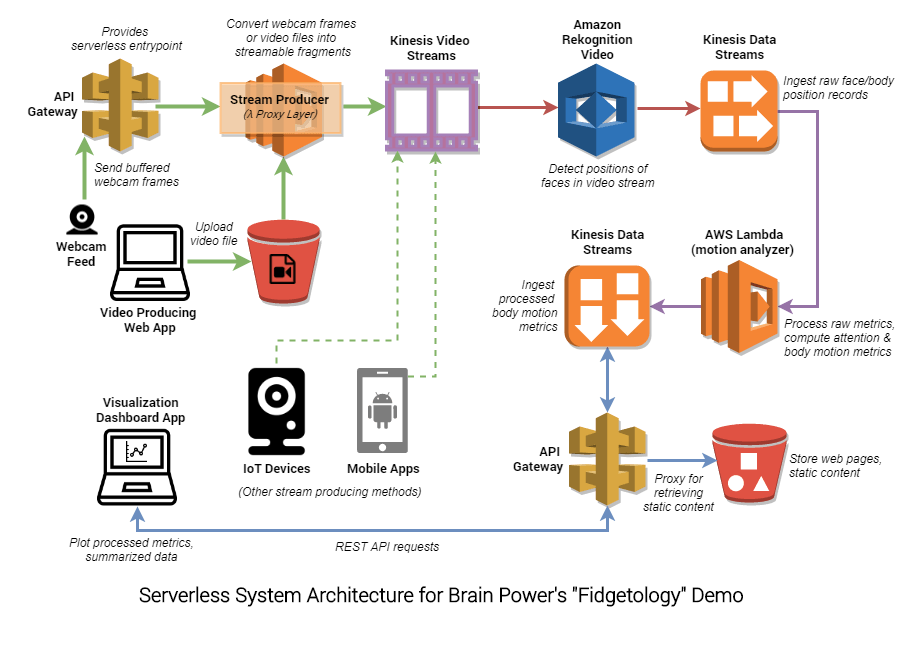
Web Dashboard App
The client dashboard app allows users to 1) upload pre-recorded video and 2) stream a webcam feed to Amazon Kinesis Video Streams, and visualize the resulting face motion metrics computed by Amazon Rekognition Video in near real-time. For details on how client-side streaming works and tools used to build the web app, see the dashboard app-specific documentation.
Uploading a Video
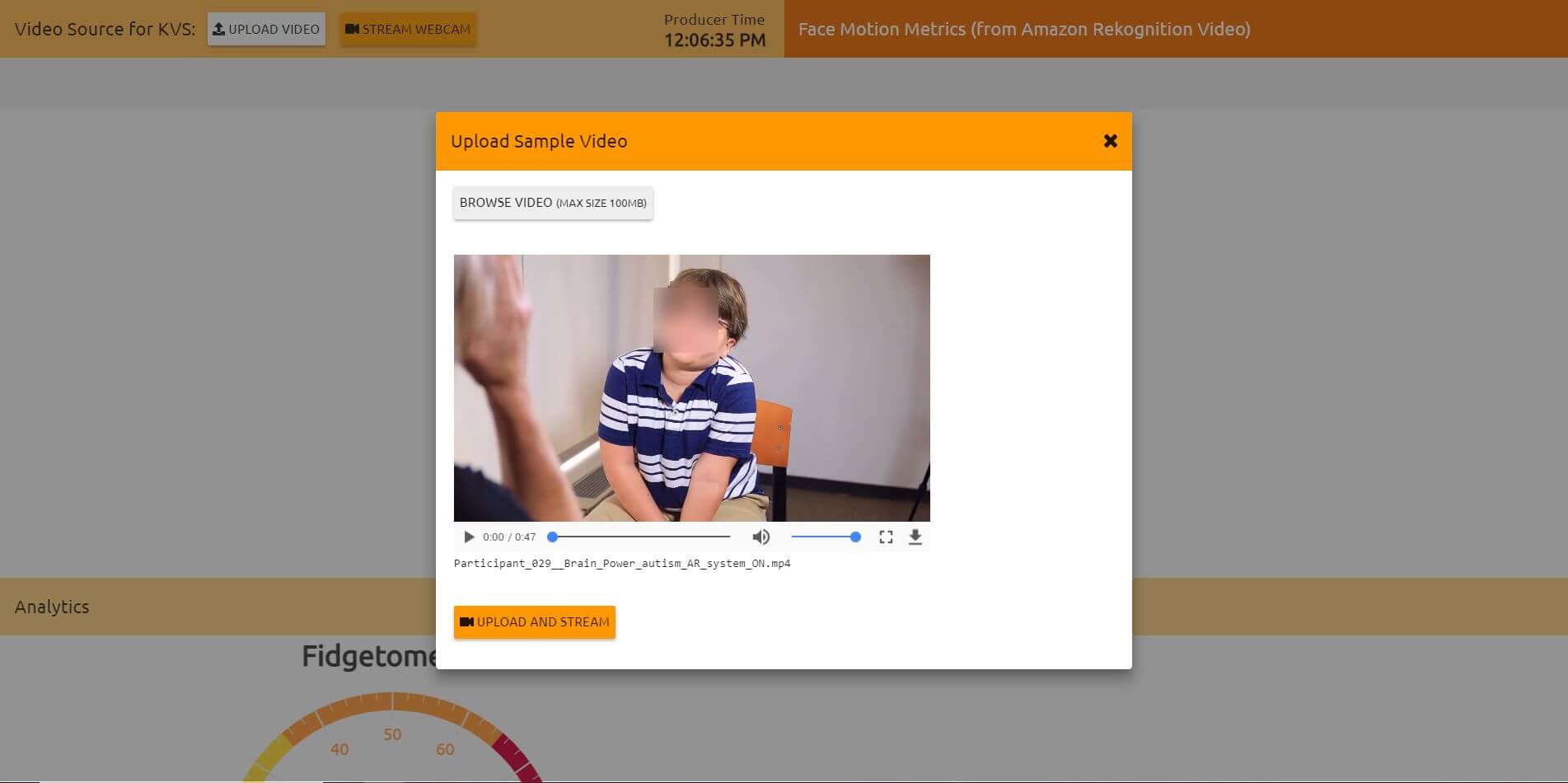
Streaming Video from a Webcam
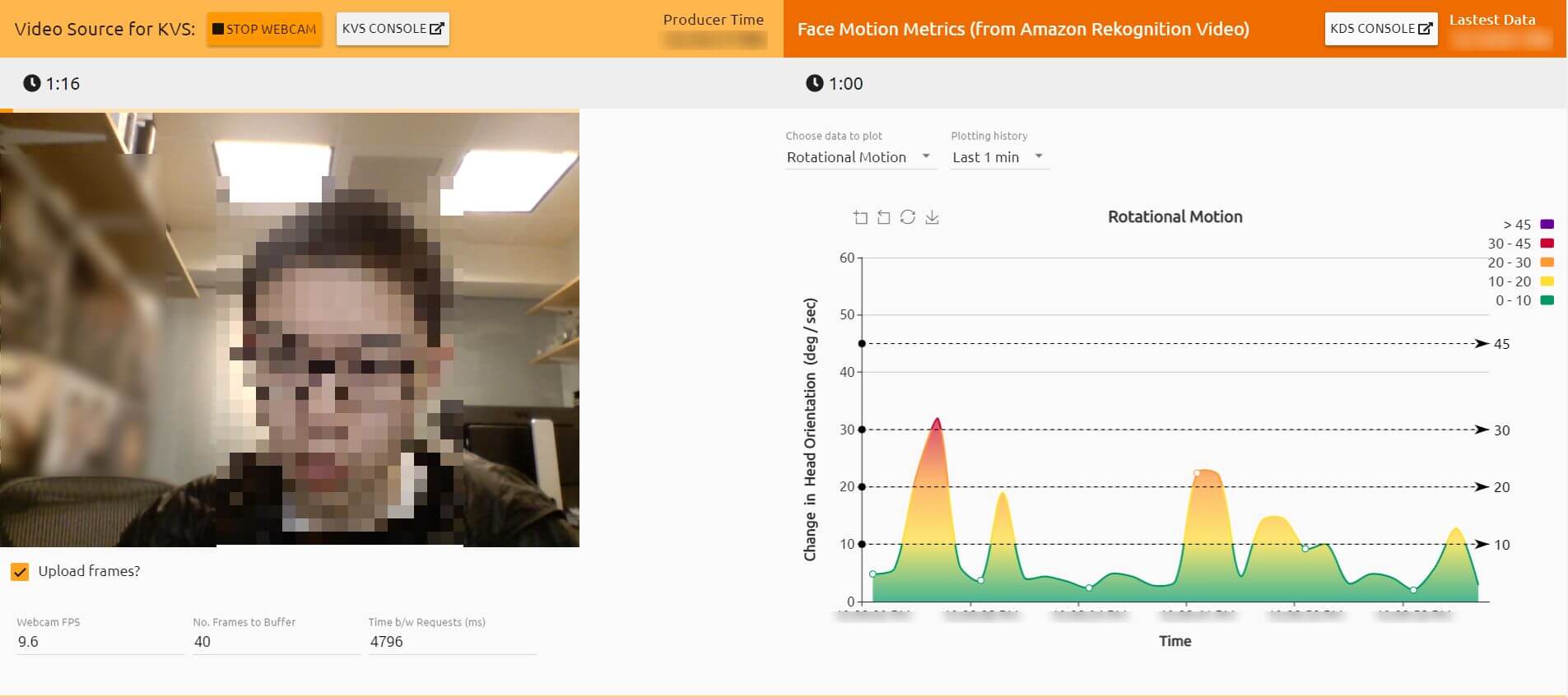
(*Faces censored)
Browser Support
The webcam streaming functionality (backed by WebRTC getUserMedia API) has been tested on the following combinations of browsers and platforms.
Most notably, it currently works on the latest version of all major browsers and platforms, with the exception of iOS mobile browsers.
| Platform | Browser | Notes |
|---|---|---|
| Windows | Chrome 30+ | Works |
| Windows | Firefox 20+ | Works |
| Windows | Edge (latest) | Works |
| Windows | IE 9+ | Requires Adobe Flash Player |
| Mac OS X | Chrome 30+ | Works |
| Mac OS X | Firefox 20+ | Works |
| Mac OS X | Safari 6+ | Requires Adobe Flash Player |
| Android | Chrome (latest) | Works |
| Android | Native browser | Doesn't Work |
| iOS | Safari/Chrome | Doesn't Work |
Stream Conversion
When static video or buffered webcam frames are uploaded in the web app, a Lambda function converts them to streamable MKV files (currently, MKV is the only file container supported by Kinesis Video Stream).
-
If the source is a static video upload, then the
lambda/MKVConverterfunction is triggered directly by an S3 upload event. An FFmpeg subprocess is used for file conversion. -
If the source is a sequence of buffered webcam frames, the browser client posts frame data to an API Gateway - Lambda Proxy endpoint, triggering the
lambda/WebApi/frame-converterfunction. This function uses FFmpeg to construct a short MKV fragment out of the image frame sequence. For details on how this API request is executed, see the function-specific documentation.
In both cases, converted MKV files are archived in an S3 bucket, triggering the next step in the pipeline.
Kinesis Video Stream
An MKV file upload event triggers the lambda/S3ToKVS function, which uses the Kinesis Video Stream Producer SDK for Java to put the media fragments into a Kinesis Video Stream.
Below is a side-by-side illustration of webcam streaming to the Kinesis Video Streams online console. The lag between the live webcam app feed (left) and the time these frames are played back on the KVS console (right) is about 5 seconds (though this may vary depending on browser/platform/specs of your machine).
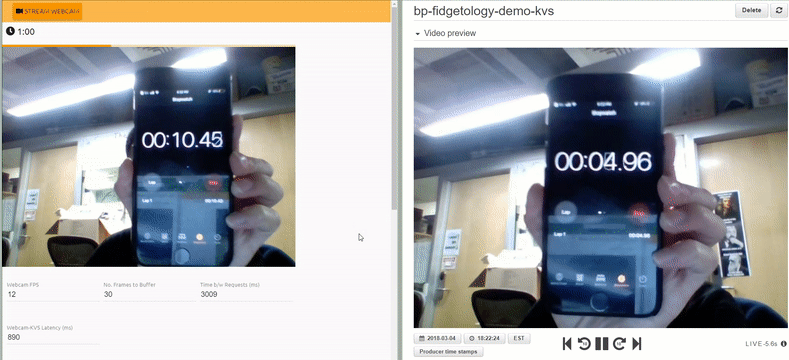
To decrease the lag, you can experiment with adjusting the No. Frames to Buffer parameter using the form input below the live webcam feed. Beware that specifying too low of a buffer size may cause KVS to receive frames out-of-order.
Misc KVS Notes
Note 1: Currently, Kinesis Video Stream Producer SDK is only available in Java/C++, so this step could not be merged with the previous stream conversion step, which runs in a Node.js container for consistently fast startup time. If a KVS Producer SDK becomes available in Node.js/Python, then this step should just be merged with the previous step (as a single Lambda execution) to avoid the needless latency of using S3 as a file transfer proxy between different Lambda containers. While a viable alternative is to do the previous stream conversion step in Java as well, the faster startup times and smaller deployment packages associated with Node.js make it more suitable for this demo. One could definitely explore re-factoring all the serverless Lambda functions in Java to see if it improves performance.
Note 2: To simplify the build process, we do not include the entire Java project associated with this S3ToKVS function. We only include the compiled, deploy-ready .jar package, and the main LambdaFunctionHandler.java file to demonstrate usage of the putMedia operation with the Java KVS Producer SDK. However, if you want modify the Lambda function handler for your own use, you must follow instructions to create a Lambda deployment package for Java, which involves using Maven/Eclipse, greatly complicating the build process. All in all, until a KVS Producer SDK becomes available in Node.js/Python, there is not an easy workaround.
Note 3: Another route is to abandon Serverless/Lambda and provision a custom AMI as a webRTC server that also handles stream conversion. This solution will probably yield the best performance and lowest latency, but is not in the spirit of this Serverless demo.
Rekognition Stream Processor
The Kinesis Video Stream is used as input to a Rekognition Stream Processor, that detects and recognizes faces in the video stream, and publishes raw records to a Kinesis Data Stream. See lambda/StreamResourceProvisioner for how these resources are provisioned.
Body Motion Analytics
The raw output of Rekognition Stream Processor is published to a Kinesis Data Stream. When new records appear in this raw stream, a Lambda function is triggered that computes interesting derived metrics on faces in successive video frames, such as the rotational/translational motion velocities. These processed metrics are then published to another Kinesis Data Stream, for consumption by downstream applications and web dashboards. See lambda/StreamAnalyzer for an example of how one might analyze the raw output of Rekognition Video.
Visualizing the Metrics
For this demo, the web app consumes body motion metrics directly from the processed Kinesis Data Stream and renders them as real-time updating chart visualizations.
Deploying
CloudFormation Deployment
There are two flavors of this project that can be deployed:
-
'Full' version - expressed in
template.yaml. Includes all components described in previous section. -
'Lite' version - expressed in
template_lite.yaml. Only includes browser Webcam to Kinesis Video Streams component. Rekognition Video, Kinesis Data Streams, and demo analytics + visualizations are excluded for simplicity.
This project can be deployed using AWS
CloudFormation as a Change Set for a New Stack (a serverless application transform must first be applied to the template.yaml definition).
Click the button to begin the stack creation process:
Step 1. Click Next, and specify brain-power-fidgetology-demo as the Stack name. Accept all default parameters and click Next.

Step 2. Click Next again to get to the final Review page. Under Capabilities and transforms, confirm acknowledgement that new IAM resources will be created. Then click Create stack.
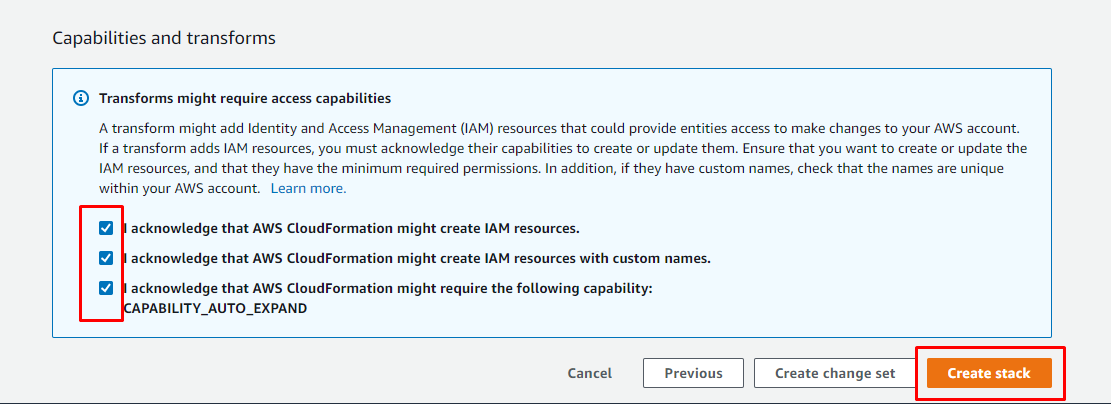
Step 3. Refresh the CloudFormation page to find your newly created stack. Click on it to monitor the deployment process, which should take no more than 3 minutes.

Step 4. After deployment is complete, launch the demo web app by visiting the WebAppSecureURL link listed under Outputs.
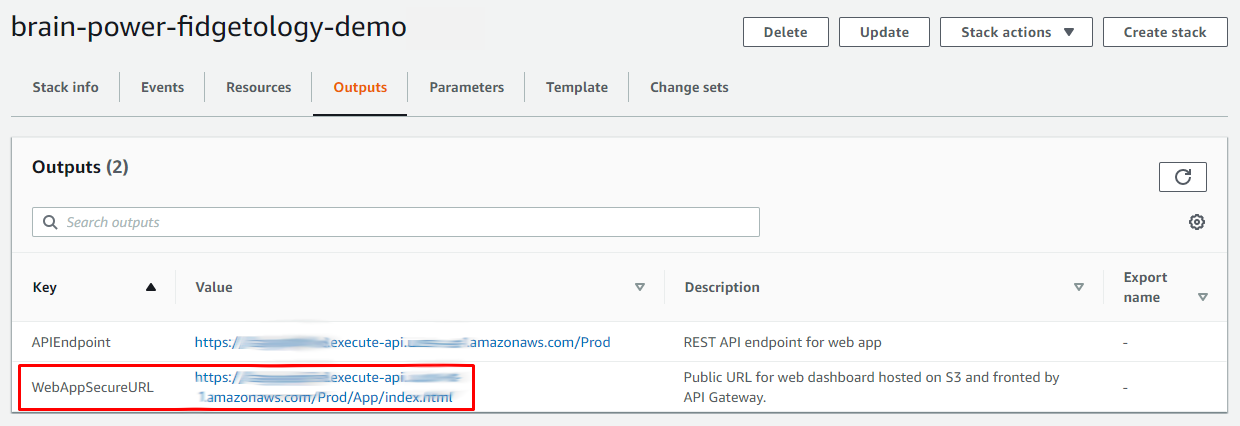
By default, the CloudFormation template creates all necessary AWS resources for this project (Kinesis Video Stream, Rekognition Stream Processor, Kinesis Data Streams, serverless Lambda functions, and an API Gateway endpoint). It copies the dashboard web application to an Amazon S3 bucket and outputs a secure URL (fronted by API Gateway) for accessing the web app.
Command Line Deployment
Prerequisites:
- (For customized deployment) AWS-CLI installed. Ensure you have required permissions on your account (most notably: S3 bucket creation/deletion, full access to Rekognition and Kinesis Video Stream. Other resources launched in this project include: Lambda, API Gateway, Kinesis Data Stream)
- (For local development only) Node.js (>= 10) installed.
The CloudFormation stack defined in template.yaml is expressed using the AWS Serverless Application Model. Review it for a description
of the configuration options and AWS resource components. The template can be modified for a custom deployment.
From the command line, you can deploy all required AWS resources and demo web app in one go using the master deploy command:
./deploy_example.sh
Note: Currently deployment is supported only in regions where AWS Rekognition and Kinesis Video Stream services are both available (as of now, these are: us-east-1 or us-west-2). If your default AWS region is not supported, you must change your default region before executing the deploy command.
This command will:
- Package code artifacts (Lambda function source files in the
lambda/directory anddashboard/static files) and upload to a bootstrapping S3 bucket. - Generate a
master-template.yamlCloudFormation template that is then deployed to your AWS account using AWS-CLI. - Configure the dashboard web app with required API routes, and upload static website files in the
dashboard/directory to be hosted from an S3 bucket. - Output the public URL of the demo web app hosted in the S3 bucket.
Usage
Running locally
If you deployed the stack using the command line, the web app can be tested locally. Please ensure you have Node.JS/NPM.
Before you run the local development server, you need to install the Node.js development dependencies with the command:
npm install
To start the HTTP server web on port 3000, issue the command:
# serves http://localhost:3000
npm start
Then navigate to http://localhost:3000 in your browser.
Tear down
If you launched the stack from the CloudFormation online console, simply delete the stack online.

If you deployed from the command line, run the master tear down command:
./delete_stack.sh
In both cases, this will tear down all AWS resources that were provisioned with the CloudFormation stack, delete all videos fragments that were uploaded/streamed using the web app, and delete the bucket hosting the web app.
Potential Improvements
- See Misc KVS Notes for potential improvements to stream conversion-to-KVS flow.
- Explore Kinesis Analytics for analyzing raw output of Rekognition stream processor, with unsupervised anomaly detection capabilities.
- Expose an API Gateway endpoint for reading from the KDS of processed motion metrics, allowing web app to avoid consuming directly from the processed stream.
- Modify
StreamAnalyzerto allow for tracking of multiple faces/bodies in a feed. - Once Kinesis Video Stream and Rekognition Stream Processor become available as CloudFormation Resource Types, add them to the template definitions, removing the need for
StreamResourceProvisionerCustom resource.

